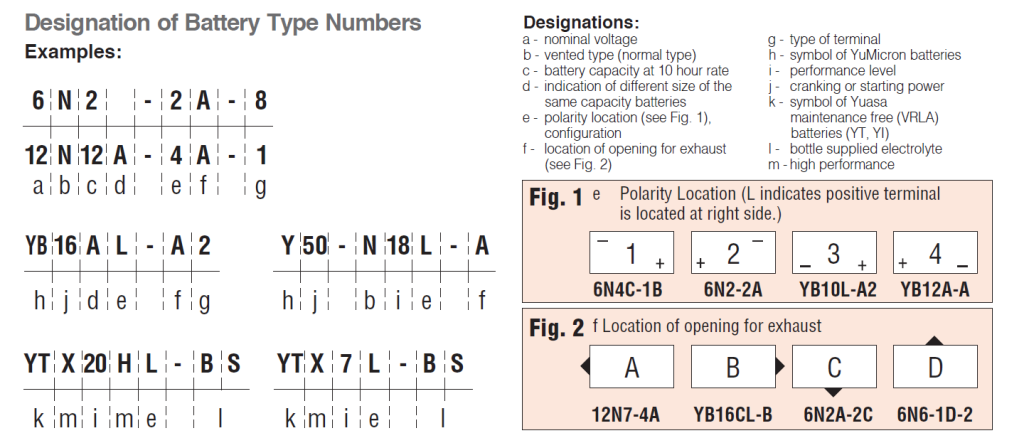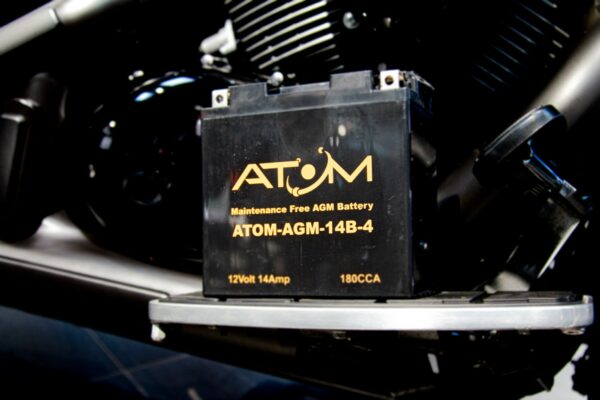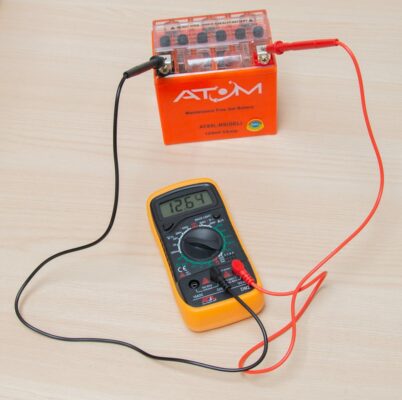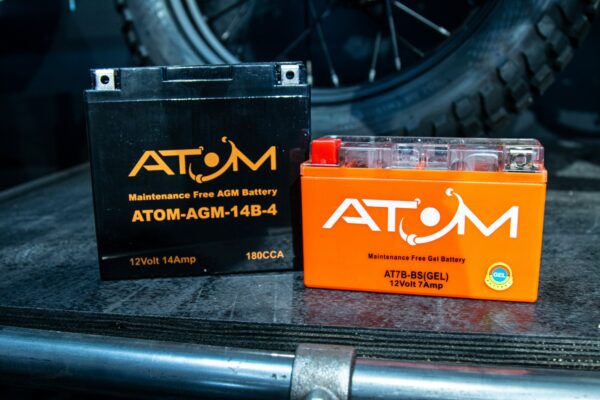Battery FAQ
Thanks for visiting our motorcycle battery FAQ page, here we’ve put together a list of answers for the questions we’re most commonly asked.
If you have the owners manual for your bike, it will hopefully list the battery you require. The parts finder on the Atom website will allow you to filter any available products which fit your bike.
Once you know the battery code you need, you have to decide on the type of battery to get. Do you have a limited budget? If so, gel or VRLA are a good option. Do you need a bit more cranking power to start your bike? Get an AGM. Is money no option? Do you want something super lightweight? Buy lithium. A good all round, high performing option for most applications is the AGM battery, though they can be heavy. You don’t necessarily need to replace your battery like for like, unless you want to. Just make sure the battery you choose is compatible with your bike.

An explanation of part numbers from Yuasa
YT – Yuasa VRLA code
N – Vented Type
X – High Performance
Z – High Performance
L – negative terminal on the left hand side
7 – battery performance indicator
BS – Bottle Supplied
Batteries with codes starting with numbers identify a traditional style lead acid battery. 6 = 6 volt, 12 = 12 volt.

CCA stands for cold cranking amps – this is a measure of the performance of a battery measured at -18ºC for 30 seconds without dropping below 7.2 volts. The higher the number, the more easily it will start your bike. If you have a large capacity motorcycle, you’ll want a decent CCA figure to ensure the bike will turn over fast enough. You can often find a recommended CCA figure for your bike online, or in a workshop manual.
Ah (amp hours) is an indication of the capacity of the battery, showing you how long it will last when a 1 amp current is drawn from it. For example, a 12Ah battery will last 12 hours with a 1 amp draw, six hours with a 2A, two hours with a 6A draw and so on. The higher the Ah number, the longer the battery is able to last. If you have a lot of accessories fitted to your bike (heated gloves, immobiliser, sat nav etc) a battery with a higher Ah rating will maintain a greater draw in power for longer.
This will depend on how often you use your bike, the quality of the battery and the type of riding you do. If you fit a cheap battery to your adventure bike and only do short trips down rocky trails, the stop/start riding, vibration and poor build quality will likely result in an unhappy battery. On the other hand, if you use your bike regularly and give the battery a chance to charge with a decent ride, it should last several years.
Where a lot of batteries tend to die is when a motorcycle is left unloved over winter. If you do not use a trickle charger to top up your battery, you’ll likely come back to your bike in spring and it won’t start. Alternatively you can charge your battery every month or two, to ensure the voltage doesn’t drop too low.
The battery will slowly but surely lose charge, and given enough time will discharge completely. Some chargers can recover batteries from a deep discharge of around 5V, but leave it too long and you will need a new battery. Lithium batteries have a lower self-discharge rate and may be OK, but bear in mind that they cannot be recovered from a deep discharge.
A disconnected lead-acid battery loses up to 1% of its charge every day at a temperature of around 20°C and discharges more quickly as the temperature drops. If the battery is left connected and is powering an alarm, clock, or anything else it will discharge more quickly. A lithium battery does not discharge as quickly as a lead-acid battery.
You will notice that your lights are dim and your bike might also struggle to turn over, or turn over very slowly. If your battery is completely dead, you might hear a buzz or a click from your starter and very little else.
A motorcycle battery will charge at idle, but the charge provided will be a lot lower than going for a ride. Simply starting a bike, letting it idle, then turning it off can actually be detrimental to the battery as it takes a lot of energy to initially start the bike. Variation in engine speed will provide more current to charge the battery, so it is always best to go for a decent ride in order to charge your battery properly.
It depends – if your bike has an alarm then leave it connected or you risk losing your bike. However the alarm slowly drains the battery so you must connect it to a smart trickle charger and leave the charger permanently on. If your bike does not have an alarm and you do not have a trickle charger and it is cold, then it is best to remove the battery and store it in a dry place at room temperature, check it every week and charge it when necessary (see Q5). If you have to store the battery in a cold place do not sit it on a concrete floor or metal surface, instead rest it on a piece of carpet or a towel, and cover it, the idea being to keep it as warm as possible. If you don’t have a power source where the bike is stored then remove the battery and charge it indoors.
First and foremost a dedicated motorcycle battery charger, not one for car batteries. Preferably use a smart/intelligent charger that regulates the amount of charge according to what the battery needs, and that switches itself off when the battery is charged and on when charge is needed. These chargers provide a trickle charge and can be left permanently connected to the battery for months. Make sure the charger is suitable for the type of battery you have, so if you have a 6V battery make sure the charger has a 6V function, and if you have a Lithium battery make sure the charger has a Lithium charging function. Most motorcycle chargers come with an adapter that you leave connected to the battery, and you plug the charger into the adapter, allowing the seat/side panel/battery cover to remain in place.
You may be able to bump start your bike, but even this may not work if another component in the charging system is the reason it stopped working. If you left your lights on and the battery is dead, a bump start should get you going.
By performing the tests mentioned at the beginning of this article, you should be able to establish if you need a new battery. You need to ensure you are diagnosing the correct part of the charging system that is causing the issue – people will often buy a new battery as that is a nice easy solution, but if your reg/rec or stator is fried, this isn’t going to do you a lot of good in the long run.
Over time a battery will develop lead sulfate on the plates when not in use. Charging and using the battery will break down this sulfation. If allowed to develop for an extended period, the sulfation on the plates will thicken and limit the charge that the battery can hold. This is the primary reason a battery will not charge. Some battery chargers include a desulfation mode which can potentially reverse the effects of a sulfated battery. If you fully charge your battery and it refuses to go above 12.4v, it’ll be sulfated.
There are ways to recover a dead battery, but it is often more cost effective to simply buy a new one. Some chargers have a desulfation mode which can help to recover a battery. Even if you can recover the battery, it will often have a lower capacity than it did when it was new.
Further Reading
For more information on motorcycle batteries and guides on usage please visit out blog.








